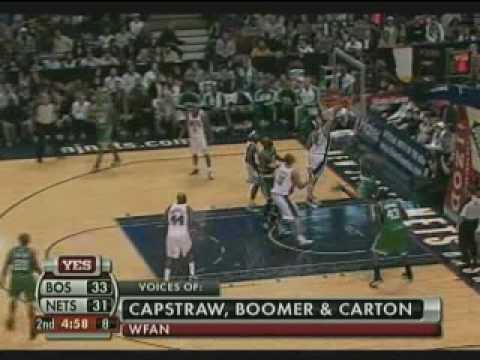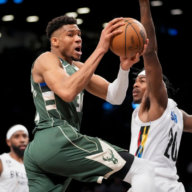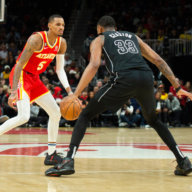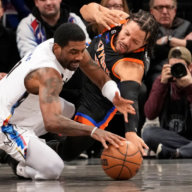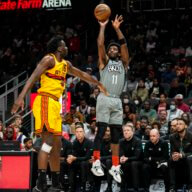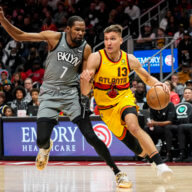Being a rookie in the NBA is tough. I mean, I don’t know it to be fact (and despite the fact that Brandon Jennings doesn’t think so), but I am pretty sure the jump from college to the pros is difficult. You have to adjust to the speed, the physicality, and to the new sets that are being ran. Continuing with my assumptions, I would assume it is pretty hard to learn one position in the NBA, let alone 4. That is what Terrence Williams is doing right now.
When the Nets drafted Terrence Williams, they were really excited about implementing his versatility, which is what they believed his biggest strength is. As soon as he arrived in camp, everyone was talking about him having the skill-set to be a “point-forward.” However, with all of the injuries the Nets have been forced to use Terrence Williams in ways nobody could have imagined. Right now, he is the back-up point guard, a back-up at the sg spot (has even started a game here), a back-up/starter at the 3, and when the Nets go small, he even plays the 4 once in a while. In fact, according to 82games.com Terrence Williams has logged key minutes at each of these 4 positions:
As you can see he has played at least 3% of the team’s total minutes at 4 different spots. When I talked to Terrence Williams yesterday he told me, “I like playing four positions, why wouldn’t I?” Terrence asked, and he concluded his answer by saying, “It’s basketball at the end of the day.” I don’t think it is as simple as that though. I mean just because he has the skill-set to play these positions doesn’t mean he has been effective in these spots. As a matter of fact, Terrence has only been “truly successful” at one of these positions.
Point Guard:
Looking just at Terrence’s PER per 48 minutes, you would think that Terrence Williams is doing a decent job at the point, the PER is a bit inflated though, mainly because he rebounds so well as a point. Given his athleticism and his size compared to other PGs in the NBA, that is a given, but what’s scary is the turnovers (4.4 per 48), and the counterpart per 48 PER (30.2). He also doesn’t force any turnovers when playing the point, and he allows opposing points to go off, as they are averaging 24.4 points per 48-minutes. The biggest problem for Terrence at the point is speed. Both the speed of the opposing PGs and the speed of the game. He has trouble staying in front of quicker point guards like Rajon Rondo:
Do you see how Terrence backs up at Rondo’s first step? That is because he knows he doesn’t have the speed to keep up with him, so he has to anticipate his move. Rondo just blows by Terrence. As for the speed of the game, Terrence Williams when running point tries to make passes that used to work in college. Here is a perfect example of that:
In college guys like Rasheed Wallace don’t exist. Most guys are long and athletic enough to help and still get his hands on a pass, which is what happens right there.
Shooting Guard:
This isn’t Terrence’s best position, but because of necessity, he has played this one the most out of all others. Remember all that depth that the Nets had at the wing spots? Well, that evaporated with all of the injuries. Because of the injuries, Terrence Williams has been the main back-up for Trenton Hassell at SG, a position that nobody talked about him playing going into the season.
Look at that eFG%. Ew. Quietly, Terrence Williams has become the Nets’ second biggest shot taker in terms of quantity:
This coincides with Terrence Williams playing more at the SG spot. During this time, Terrence Williams’ shooting percentage plummeted. It went from “hmm…maybe Terrence can shoot the ball.” to “He needs a ton of work.”
Small Forward:
The small forward spot is, without question, Terrence’s best position. This is because he is quicker than most 3s in the NBA, and his size and strength allows him to D up against SFs very well.
As you can see the eFG% is high, the PER is good, but most importantly, the opposing PER is low. In fact the SF spot is the only spot where Terrence Williams has a positive Net PER. It is also nice to see the rebounding rate stay high, and the assists stay where they are too. When Terrence Williams plays the SF spot, stuff like this happens:
Remember how Terrence took a step back when Rondo was driving on him? Well doesn’t that look like what Paul Pierce did right there? That means that opposing SFs are worried about Terrence’s speed.
Power Forward:
I am not going to waste the time posting the numbers here, but as you can imagine, Terrence gets out-rebounded from this spot. The eFG% of opposing 4s when he plays the PF spot is 100%, which means that he is just plain outmatched in this spot. The advantage of using Terrence at the 4 is at the offensive end, and with the main pieces for the Nets “wildcat” not in action, that advantage seems to be lost, which means we shouldn’t be seeing Terrence at the four much.
—
So what does this all mean? Well, first knowing that SF is his best position, when you see him go out there ready to play the SF spot, you know he will be successful.
Looking at these numbers, you also have to remember not to judge Terrence as a “bust” too early, even though some people (ahem Hollinger) are. He’s not choosing to play all these positions, he is doing it out of necessity. Just look at the numbers, he is playing the most time at the position he is arguably the worst at. Lets just wait until the Nets get healthy allowing Terrence Williams to slide back to his natural position on a more consistent basis. Once that happens, we should be able to see a major uptick in the quality of his play.

